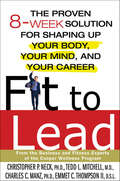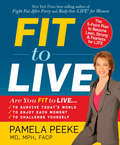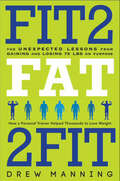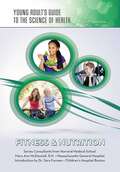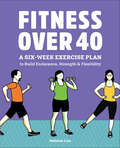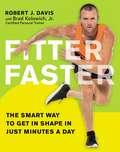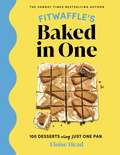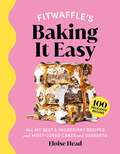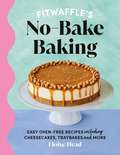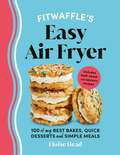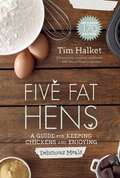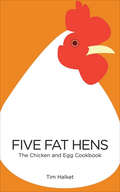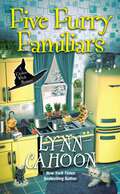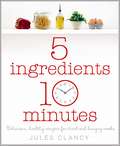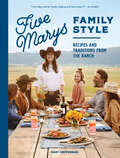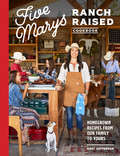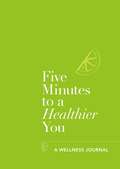- Table View
- List View
Fit in 50 Days: Creating the Habits that will Keep You Lean for Life
by Martin BrownIn 50 days, you can change your life forever. You can create the healthy habits that will keep you lean for life. And, you can do it all in just seven weeks and a day. Most importantly, you can put an end to yo-yo dieting, and the unhealthful cycle of getting in and out of being fit.Getting fit -- and staying fit -- is considered by most of us to be a wonderful but unattainable goal. Fit in 50 Days disproves that idea. This is a step-by-step, day-by-day program that is rooted in the common sense realities of how we live now. In each passing year, as we continue to consume more calories and have fewer physical demands put upon us, inevitably our weight will rise. The simple arithmetic of calories consumed and calories burned comes easily. The really tough part is finding lasting solutions to this problem.Even with the defeat of once deadly infectious diseases, overall health outcomes in today's culture are abysmal. Through technology and modern medicine we have managed to expand life spans, but our health spans, the years we experience general good health, are considerably shorter: a situation that most of us would agree is the least desirable, living a longer unhealthy life.You can take control of your own health now with this easy-to-adopt and easy-to-follow fitness plan. It is the single most important thing you can do to help assure that in the future you will not be one of the living sick. And if your health is already compromised Fit in 50 Days can be an essential tool to restoring your health and vitality. This program creates a framework in which you can shape your own specific performance level. That's why Fit in 50 Days works for all ages and stages of life.Remember that lasting fitness is far more than a New Year's resolution. Diet and exercise are of equal importance and that is why Fit in 50 Days devotes equal attention to both subjects. Successful diets that allow you to quickly lose extra pounds should never be a detour around your usual diet. Lasting fitness is a habit, and in just 50 days, this program will change your view of diet and exercise forever.If you're ready for a new and successful direction, then you're ready for the daily lessons of Fit in 50 Days. If you thought that lasting weight loss was not possible, you're in for a wonderful surprise. You'll be equally amazed that with focus and simple exercises your body will quickly begin to improve and strengthen. Today, whether you're twenty-one or seventy-one, there's a good chance you have not taken full advantage of the marvelous gift that is your body. Fit in 50 Days will change all that as you learn to leave bad dietary habits behind, grow stronger and more flexible, reset your health priorities, and experience the joy that comes when you feel yourself growing stronger with each passing day.If you're ready for this journey, buy Fit in 50 Days NOW and claim the more active life and better health you deserve.
Fit to Lead: The Proven 8-Week Solution for Shaping Up Your Body, Your Mind, and Your Career
by Charles C. Manz Christopher P. Neck Tedd L. Mitchell Emmet C. Thompson IIA proven program to help busy executives get Fit to Lead.Are you a leader at work, at the expense of your health? Did you give up exercise after college, and stop watching your diet when you made it to senior partner? Are too little sleep, fast food, and a hectic, catch-up lifestyle all you allow yourself?This proven, simple program is based on the sound principles that have helped thousands of top executives, including President George W. Bush, get - and stay - in shape. The results are not just looking and feeling better, but performing better on the job, becoming a more effective leader, and inspiring others to follow your lead.
Fit to Live: The 5-Point Plan to be Lean, Strong, and Fearless for Life
by Pamela PeekeNew York Times bestselling author Dr. Pamela Peeke helps readers trim their waists, shed pounds, and lengthen their lives in her witty, tough-love functional fitness and lifestyle plan.Dr. Pamela Peeke's New York Times bestseller Body-for-LIFE for Women helped scores of readers transform their bodies. Her newest book shines light on the heavy weight of the 21st century lifestyle, with its fake food, desk jobs, clutter, and endless stress, and asks readers, "If your life depended on it, could you run up four flights of stairs right now? Are you Fit to Live, not only to survive, but to enjoy life?" For most people, the answer is no and they don't know it. Combining Peeke's trademark in-your-face wit with heart-stopping reality checks, Fit to Live offers readers an active health/lifestyle assessment: How many pushups can they do in 2 minutes? How many servings of processed foods did they eat today? Peeke translates those results into research-based predictions of readers' long-term prognoses and helps readers gauge just how much fat—mental, nutritional, physical, financial, environmental—to cut from their toxic lifestyles to become Fit to Live. Showing how these five core areas intertwine, Peeke offers bottom-line strategies to adapt and adjust to life's stresses; get a stronger, leaner body; enjoy greater financial security; and create a healthier living space. Readers will become Fit to Live and lead dynamic and exciting lives, both now and for the future.
Fit2Fat2Fit: The Unexpected Lessons from Gaining and Losing 75 lbs on Purpose
by Drew ManningA fitness trainer’s true story of gaining 75 pounds so he could better understand his clients’ struggles—and what he learned while getting back in shape.Drew Manning, a fitness junkie and personal trainer, had never been overweight in his life. He never craved junk food or missed an opportunity to work out. Yet despite his obsession, he failed to help his clients reach their goals. Manning decided he needed to understand what it was like to be in his clients’ shoes—or, rather, size.For six months, he radically let himself go. He stopped exercising and ate nothing but the typical American diet of fast and processed foods. Not surprisingly, he gained weight. Manning made national news when he posted a blog revealing that he’d gained more than 60 pounds (he ended up gaining 75). In only half a year, the out-of-shape trainer-turned-blogger had gained more than he ever expected—and not just in pounds.Manning devoted the next six months to losing the weight as quickly as he’d gained it. The lessons he learned from experiencing both sides of the battle were priceless. What started as a physical challenge became an emotional and mental wake-up call. In Fit2Fat2Fit, Manning reveals the practical takeaways and profound insights of his yearlong journey. With startlingly honest stories, concrete, easy-to-implement strategies, recipes, exercises, workout routines, meal plans, and much more, he equips readers to achieve any weight-loss goal. Also included are a chapter by his wife, and before and after (and after) photos.
Fitness & Nutrition: A Teen's Guide To Fitness And Nutrition (Young Adult's Guide to the Science of He #15)
by Christopher HoviusDo you ever wish you were stronger...thinner...more athletic...healthier? Most of us would change at least one thing about ourselves if we could. But real health and happiness aren't dependent on matching yourself against the unrealistic ideals of a model-thin body or a pumped-up body builder's bulging muscles. Instead, fitness and good nutrition are the two factors that can lead to physical and emotional health. When you were younger, your parents told you what to eat. They probably encouraged you to eat the foods that would provide you with the various nutrients you needed to grow. They may have also encouraged you to get regular exercise. But you're older now. You've begun to make your own decisions about what you eat and how active you are. Learning what your body needs to be healthy is an important part of becoming a responsible adult. Taking care of yourself makes sense if you want to be happy and enjoy life. This book will tell you how to be the best you can be!
Fitness Over 40: A Six-Week Exercise Plan to Build Endurance, Strength, & Flexibility
by Stefanie LisaBoost your fitness with an exercise plan you can complete anywhereStaying active is an important part of keeping fit. But as we age, it can be harder to keep up with a fitness routine. Fitness Over 40 delivers a comprehensive method for staying in shape and improving the energy levels that may decline from aging. Find a six-week plan specially geared toward anyone over 40 looking to improve strength, balance, flexibility, and endurance.Whether you're working out from home or at the gym, this fitness planner features workouts you can do with or without exercise equipment, so you can get started on a fitness routine that works for you.Antiaging science 101—Discover the science behind aging, the benefits of exercise for the mind and body, and what to expect decade by decade.Plans tailored to you—Get started on the customizable "Fire It Up" workout routines that target different muscle groups and keep you challenged as you grow stronger.Fitness and nutrition guides—Empower yourself with helpful information about nutrition, supplements, and the benefits of a general fitness plan after 40.Age gracefully and exercise your way toward improved strength and flexibility.
Fitter Faster: The Smart Way to Get in Shape in Just Minutes a Day
by Robert Davis Brad KolowichA lifetime of fitness in just minutes a day. I don't have time . . . I'm too tired . . . I hate gyms . . . These are among the most common excuses for not exercising. But the truth is that getting in shape requires less time and effort than you might think. Examining everything from pre-workout stretches to post-workout protein shakes, this science-backed book slices through fitness fads and misconceptions to reveal how you can exercise quickly and effectively. For example, is it best to exercise in the morning? Does aerobic activity burn more fat than weight lifting? You'll also learn how to get and stay motivated, what equipment to buy (and what not to waste money on), which dietary supplements really help, and how to combat muscle soreness. Fitter Faster explains how to: Find the right balance between cardio, strength, and stretching * Slash workout times with high-intensity interval training * Prevent boredom * Enhance fat-burning The accompanying Fitter Faster Plan, developed with celebrity trainer Brad Kolowich, Jr., pulls everything together. Requiring as little as 15 minutes a day, these quick workouts maximize efficiency-allowing you to reap the greatest benefit in the shortest possible time...all without ever having to set foot in a gym. With photographs illustrating each exercise routine, this eye-opening book will forever change the way you work out- and help you get fitter faster.
Fitter Faster: Your best ever body in under 8 weeks
by David KingsburyDrop up to 4 pounds a week, safely and sustainably, with the revolutionary 8 week fat-loss plan from acclaimed celebrity personal trainer, David Kingsbury. Most diets don't work because they aren't personalised to YOU. David has combatted that, providing tailored menus and movement plans that can be applied to anyone. Split into three sections, the route to a healthier, slimmer you has never been so easy:1) THE PLAN - how to tailor your calorie intake and movement regime to achieve your personal goals2) THE RECIPES - over 70 easy, delicious and healthy meals to ensure weight-loss while keeping you satisfied3) MOVEMENT - simple exercise routines that provide results fastUsing the methods that have worked on the actors and actresses in X Men, Wolverine and Mamma Mia 2 to name a few, David's easy, achievable plan will help you get the body you've always dreamed of, for good.
Fitter Faster: Your best ever body in under 8 weeks
by David Kingsbury.Drop up to 4 pounds a week, safely and sustainably, with the revolutionary 8 week fat-loss plan from acclaimed celebrity personal trainer, David Kingsbury.Most diets don't work because they aren't personalised to YOU. David has combatted that, providing tailored menus and movement plans that can be applied to anyone. Split into three sections, the route to a healthier, slimmer you has never been so easy:1) THE PLAN - how to tailor your calorie intake and movement regime to achieve your personal goals2) THE RECIPES - over 70 easy, delicious and healthy meals to ensure weight-loss while keeping you satisfied3) MOVEMENT - simple exercise routines that provide results fastUsing the methods that have worked on the actors and actresses in X Men, Wolverine and Mamma Mia 2 to name a few, David's easy, achievable plan will help you get the body you've always dreamed of, for good.
Fitter, Happier, Healthier: Discover the strength of your mind and body at home
by Kate FerdinandBecome Fitter, Happier, Healthier with Kate's secrets for harnessing your strength, caring for your mind and making your body feel great from your own home'Eminently relatable. Non-faddy, easy to cook recipes and a well-explained and doable exercise programme' The Times'She aims to encourage body confidence by making exercise enjoyable for everyone' Sunday ExpressExercise has always been important to Kate, for both the physical and mental benefits. Now, she has developed the ultimate guide to taking control of your physical and mental wellbeing in a truly enjoyable way, without the need for fancy expensive equipment or a gym membership.With insights into her personal regime and how she maintains a positive mental attitude, Kate will guide you through how she stays motivated, healthy and happy!Inside this fully-illustrated guide you'll find:· 4 weeks of empowering at-home exercises for you to follow and gradually build up your fitness· Simple step-by-step instructions for upper body, lower body, and full-body HIIT workouts· Warm-up and cool-down exercises to take care of your body's recovery and mobility· 30 simple and healthy recipes for breakfasts, light meals, main meals & snacks to fuel your exercise and boost your energy· Kate's top tips and advice on how she maintains a healthy lifestyle, stays motivated, manages her anxiety and more· Space for you to fill in your goals and weekly meal plansWith Fitter, Happier, Healthier, Kate will show you how to feel great through exercise, nourish your body and maintain a proactive routine from your own home so you can feel motivated, energised and - most importantly - happy.AS SEEN IN THE SUN
Fitter. Calmer. Stronger.
by Ellie GouldingListen to your body. Calm your mind. Find your strength.Forget prescriptive 28-day plans and fad diets that are sooner or later abandoned. The truth is they don't work - and they don't make you happy. Pop powerhouse Ellie Goulding's much sought-after fitness and health philosophy is based around becoming the brightest, strongest version of yourself. This means prioritising self-care and flexibility, and approaching wellness from a perspective that is sustainable; one that doesn't leave you feeling like you've failed and, most importantly, allows room for fun and creativity.Combining a mindful approach to exercise with delicious, nutritious recipes, this book will help you kickstart healthy habits, develop a positive mindset and establish clear and achievable goals. Going far beyond diet and exercise, Ellie shares a holistic approach to feeling and being your best. From learning to listen to your body to establishing permanent rituals that work for you, it encompasses all that improves your relationship with your physical and mental health.Ellie Goulding has amassed multiple UK #1 singles, Brit Awards and Grammy nominations over the past decade of her stellar career. Now, after years of inspiring fans with her love of fitness and wellness, in her first book Fitter. Calmer. Stronger. Ellie shares her favourite recipes, workouts and training principles. Drawing on her own experiences, as well as the advice of friends and experts like Matt Roberts, Fearne Cotton and Katie Taylor, these are tools and techniques you can implement every day to build a calmer, stronger you.
Fitter. Calmer. Stronger.
by Ellie GouldingListen to your body. Calm your mind. Find your strength.Forget prescriptive 28-day plans and fad diets that are sooner or later abandoned. The truth is they don't work - and they don't make you happy. Pop powerhouse Ellie Goulding's much sought-after fitness and health philosophy is based around becoming the brightest, strongest version of yourself. This means prioritising self-care and flexibility, and approaching wellness from a perspective that is sustainable; one that doesn't leave you feeling like you've failed and, most importantly, allows room for fun and creativity.Combining a mindful approach to exercise with delicious, nutritious recipes, this book will help you kickstart healthy habits, develop a positive mindset and establish clear and achievable goals. Going far beyond diet and exercise, Ellie shares a holistic approach to feeling and being your best. From learning to listen to your body to establishing permanent rituals that work for you, it encompasses all that improves your relationship with your physical and mental health.Ellie Goulding has amassed multiple UK #1 singles, Brit Awards and Grammy nominations over the past decade of her stellar career. Now, after years of inspiring fans with her love of fitness and wellness, in her first book Fitter. Calmer. Stronger. Ellie shares her favourite recipes, workouts and training principles. Drawing on her own experiences, as well as the advice of friends and experts like Matt Roberts, Fearne Cotton and Katie Taylor, these are tools and techniques you can implement every day to build a calmer, stronger you.
Fitter. Calmer. Stronger.: A Mindful Approach to Exercise and Nutrition
by Ellie GouldingForget prescriptive 28-day plans and fad diets that are sooner or later abandoned. They don&’t work--and they don&’t make you happy. Pop powerhouse Ellie Goulding&’s much sought-after fitness and health philosophy is based around becoming the brightest, strongest version of yourself. This means prioritizing self-care and flexibility and approaching wellness from a perspective that is sustainable--one that doesn&’t leave you feeling like you&’ve failed and, most importantly, allows room for fun and creativity.Combining a mindful approach to exercise with delicious, nutritious recipes, this book will help you kickstart healthy habits, develop a positive mindset, and establish clear, achievable goals. Going far beyond diet and exercise, Ellie shares a holistic approach to feeling and being your best. From learning to listen to your body to establishing permanent rituals that work for you, the book encompasses all that improves your relationship with your physical and mental health.Ellie Goulding has amassed multiple UK #1 singles, Brit Awards, and Grammy nominations over the past decade of her stellar career. Now, after years of inspiring fans with her love of fitness and wellness, in her first book, Fitter. Calmer. Stronger., Ellie shares her favorite recipes, workouts, and training principles. Drawing on her experiences, as well as the advice of friends and experts like Ant Middleton, Fearne Cotton, and Katie Taylor, you can use these tools and techniques every day to build a fitter, calmer, stronger you.
Fitwaffle's Baked in One: 100 Desserts Using Just One Pan
by Eloise HeadOne of the most popular bakers on Instagram and TikTok, Eloise Head (AKA @Fitwaffle), presents a mix of 100 brand new and fan-favorite recipes for simple, decadent one pan desserts. Why the pan? After doing some research, Eloise selected the aluminum pan for how versatile it is and how easy it is to use. Don't have a pan that's exactly the right size? No problem! As long as the pan is deep enough, you can bake almost anything with an average-sized batch of batter or dough. With several 5-ingredient-or-less recipes such as Chocolate Chip Banana Breakfast Bars or Apple Puff Tarts, Eloise makes baking a breeze for novice and expert bakers alike. 100 RECIPES: Create mouthwatering treats for every occasion, such as cakes, cookies, sweet breakfasts, and show-stopping desserts in minutes QUICK AND EASY: Whip up mouthwatering recipes in no time such as Chocolate-Stuffed Brookies or Snickerdoodle Blondies with just a small handful of ingredients SOCIAL MEDIA SENSATION: Eloise Head (AKA Fitwaffle) has one of the most popular baking accounts on Instagram and TikTok. Her innovative recipes have been featured in The Today Show, Daily Mail, Insider, and HuffPost INSPIRING IMAGES: Filled with beautiful food photography to help inspire and ensure success GREAT GIFT FOR NEW BAKERS: With easy-to-follow instructions, cooking tips, and short ingredient lists, cooks of every skill level can make delicious sweets and desserts at home.
Fitwaffle's Baking It Easy: All My Best 3-Ingredient Recipes and Most-Loved Cakes and Desserts
by Eloise HeadOne of the most popular bakers on Instagram and TikTok, Eloise Head (AKA @Fitwaffle), presents 100 new and favorite recipes for simple, decadent desserts. With 50 three-ingredient recipes including Cookies and Cream Fudge and a Chocolate Hazelnut Mug Cake, four- and five- ingredient recipes such as Peanut Butter Blondies and a Cinnamon Roll in a Mug, plus special-occasion treats that pull out all the stops, Eloise makes baking a cinch for novice and expert home bakers alike. 100 RECIPES: Create mouthwatering treats for every occasion including cakes, cookies, bars, sweet breakfasts and show-stopping desserts in minutes QUICK AND EASY RECIPES: Whip up mouthwatering recipes such as Tangy Lemon Bars, Popcorn Balls, and Stuffed Cookie Cups with just a handful of ingredients. More than 50 recipes have only three ingredients! SOCIAL MEDIA SENSATION: Eloise Head (AKA Fitwaffle) has one of the most popular baking accounts on Instagram and TikTok. Her innovative recipes have been featured in The Today Show, Daily Mail, Insider, and HuffPost INSPIRING IMAGES: Filled with beautiful food photography to help inspire and ensure success GREAT GIFT FOR BEGINNING BAKERS: With easy-to-follow instructions, cooking tips, and short ingredient lists, cooks of every skill level can make delicious sweets and desserts at home.
Fitwaffle's No-Bake Baking: The Sunday Times Bestseller
by Eloise HeadAs seen on Blue Peter and This MorningStar baker Fitwaffle brings you 100 delicious recipes that don’t use an oven.Who doesn’t love a no-bake? From cheesecakes, ice cream and truffles to desserts made on the hob, in a microwave and air fryer, not one of these recipes needs you to turn on your oven.You’ll find brand-new recipes using popular flavours, as well as highly-requested fan favourites, lots with fewer than 5 ingredients and one-tin options to save on washing up. There are even no-bake brownies, cookies and cakes, plus 10 savoury recipes – so you’ll find something for everyone.Includes:Triple Chocolate Mousse CakeVery Berry Cream PieSpeculoos Millionaire’s BarsWhite Chocolate and Raspberry CheesecakeCookie Cups for TwoWhite Chocolate Cheesecake TrufflesPeanut Caramel Fudge…and so much more!Number One Sunday Times bestseller, March 2024
Fitwaffle’s Easy Air Fryer: 100 of my best bakes, quick desserts and simple meals
by Eloise HeadMouth-watering recipes from Fitwaffle, ready in a flash - including both sweet and savouryFrom delicious desserts to satisfy your sweet tooth, such as Peanut Butter Lava Cakes, to speedy meals including Chicken Tender Tacos and classic bakes like Berry Crumble, all of these recipes are tasty, quick and oh-so-simple.Includes 50 sweet and 50 savoury recipes, so you can enjoy Fitwaffle goodies all day long.
Five Fat Hens: A Guide for Keeping Chickens and Enjoying Delicious Meals
by Tim HalketA love of eating and of good ingredients led Tim to build a henhouse in the corner of his garden for a daily harvest of fresh eggs. His take on the role of keeping chickens is amusing and insightful, but this book is more than just a DIY guide to keeping a few free-range birds, or a new slant on a chicken-themed cookbook. Much in the style of Nigel Slater’s Kitchen Diaries, it takes the reader through an entire year, month-by-month, skillfully combining the author’s passion for cooking in diary form interwoven with his recipes, thoughts, and observations and with the premise that even the smallest garden can be home to a supply of the freshest eggs imaginable.Tim Halket is neither a trained chef nor a smallholding farmer; his recipes draw on his real-life experience in the kitchen where he reproduces food that he enjoys cooking on a daily basis for his family and friends. He ranges from the highly original such as Duelos y Quebrantos and Persian Chicken Supper through variations on everyday Italian or French classics to simple and comforting nursery food.This timely book passionately describes an appealing style of life and will inspire food lovers whether they intend to keep chickens or not.Skyhorse Publishing, along with our Good Books and Arcade imprints, is proud to publish a broad range of cookbooks, including books on juicing, grilling, baking, frying, home brewing and winemaking, slow cookers, and cast iron cooking. We’ve been successful with books on gluten-free cooking, vegetarian and vegan cooking, paleo, raw foods, and more. Our list includes French cooking, Swedish cooking, Austrian and German cooking, Cajun cooking, as well as books on jerky, canning and preserving, peanut butter, meatballs, oil and vinegar, bone broth, and more. While not every title we publish becomes a New York Times bestseller or a national bestseller, we are committed to books on subjects that are sometimes overlooked and to authors whose work might not otherwise find a home.
Five Fat Hens: The Chicken and Egg Cookbook
by Tim HalketI was born at home just in time for lunch the doctor lured me out with a cold roast chicken sandwich. Dad had just popped downstairs to make up a few rounds one for the doctor, another for the midwife and one for himself. Mum was busy... So says Tim Halket in the introduction to his engaging and original book, Five Fat Hens. A love of eating and good ingredients led Tim to build a hen house in the corner of his garden for a daily harvest of fresh eggs.His take on the role of keeping chickens is amusing and insightful but this book is more than just a DIY guide to keeping a few free range birds, or a new slant on a chicken themed cookbook. Much in the style of Nigel Slaters Kitchen Diaries, it takes the reader through an entire year, month by month, skillfully interweaving the authors passion for cooking in diary form with his recipes, his thoughts and observations and with the premise that even the smallest garden can be home to a supply of the freshest eggs imaginable. Tim is neither a trained chef nor a small-holding farmer, his recipes draw on his real experience in the kitchen and he reproduces food that he enjoys cooking on a daily basis for his family and friends. He ranges from the highly original such as Duelos y Quebrantos and Persian Chicken Supper through variations on everyday Italian or French classics to simple and comforting nursery food.This timely book passionately describes an appealing style of life and will inspire all food lovers whether they intend to keep chickens or not.
Five Furry Familiars (Kitchen Witch Mysteries #5)
by Lynn CahoonIn the latest enchanting mystery from New York Times bestselling author Lynn Cahoon, kitchen witch Mia Malone is working as a catering director at a ski lodge, but when her roommate&’s ex checks in, everything starts going downhill . . . To keep her cooking school and catering business, Mia&’s Morsels, afloat, Mia&’s handed off oversight to her boyfriend Trent&’s mother while she focuses on earning a steady paycheck. Too bad her mean-spirited boss at the lodge keeps the misery flowing as steadily as the money. At least her roommate, Christina, is still dedicated to Mia&’s Morsels—though she&’s also distracted, thanks to her clingy mother&’s constant demands. And the distraction only grows when Christina&’s old flame shows up in Magic Springs, Idaho, in his Escalade, claiming out of the blue to be her fiancé. The arrival of some homeless kittens, as well as Trent&’s new familiar, a cute little Maltese, brings more chaos—as well as a strange spiritual energy that seems to emanate from the animals. But before Mia can figure out what kind of paranormal pets she has on her hands, she finds herself with a murder to solve—when a dead woman is found in the lodge rental of Christina&’s suddenly attentive ex . . .
Five Ingredients, Ten Minutes
by Jules ClancyCook up a storm in the kitchen every day. Delicious AND healthy food, using five ingredients, and just ten minutes cooking time.Make midweek meals, simple, quick and healthy with Five Ingredients, Ten Minutes. It is designed to come to the rescue when the 'What's for dinner?' question crosses your mind. From vegetable white bean stew to lamb fillet with fresh mint and hummus to creamed spinach with chickpeas to French toast with raspberry sauce, with Jules Clancy cooking quickly at the end of a long day shouldn't be a difficulty any more!Jules Clancy trained as a food scientist, before working for Kellogg, a wine company, and then as a designer of chocolate biscuits and cookies. She's is now a full-time blogger, with a virtual cookery school specialising in quick and easy, simple food.'Cause for major celebration' Telegraph
Five Marys Family Style: Recipes and Traditions from the Ranch (Five Marys Ser.)
by Jess Thomson Mary HeffernanFollowing up on her popular cookbook, Five Marys Ranch Raised, Mary Heffernan reveals family life on the ranch through the traditions, crafts, and meals they share together throughout the year. I want to make everything from this cookbook!"--Tieghan Gerard, Half Baked HarvestArranged around 17 themed menus for favorite family events and activities, Five Marys Family Style takes the reader on a journey through the seasons and customs that drive life on the ranch. Featuring more than 75 rustic, hearty recipes, inside readers will discover the Heffernan family's Thanksgiving and Christmas traditions, menus for a cozy fireside dinner, a summer cookout, a pack-ahead picnic, or an end-of-week taco fiesta. Sprinkled throughout the book are simple, crafty DIY projects that Mary and her four daughters have fun making together, including indigo-dyed tea towels, flower-filled holiday table runners, and hand-rolled beeswax candles. Along the way, Mary shares stories of life on the ranch as well as the faithful traditions and strong connections she maintains with her extended family. Lush photography captures the expansive beauty of the ranch, the animals, including dogs, cats, and horses, and of course, Mary and her beloved husband and ranching co-partner, Brian.&“This is the definition of simple, fun, and beautiful food. Giddyup and start cookin&’!!!&”--Al Roker
Five Marys Ranch Raised Cookbook: Homegrown Recipes from Our Family to Yours
by Mary Heffernan Kim LaidlawRustic Recipes and Ranch Life Meet Mary Heffernan. Rancher. Entrepreneur. Restaurateur. Wife. Mother. Together with her husband, Brian, they own Five Marys Farms and are raising their four daughters--all named Mary--while pasture-raising cattle, pigs, and heritage lambs. Their work ethic is as strong as their commitment to family, and Mary believes in nourishing meals shared together--in their cozy cabin in winter and around the outdoor camp kitchen in summer. In these 75 satisfying, homespun recipes you&’ll find something for every meal and mood, including Mary&’s favorite beef, pork, and lamb dishes, as well as the secret to her famous sidecars! Evocative photos capture the breathtaking beauty of the ranch, the carefree joy of the girls with their horses, the majestic Great Pyrenees who roam the land, and so much more. Get ready to fall in love with ranch life, hearty recipes, and the Five Marys. Some of Mary&’s favorite recipes include: Homemade English MuffinsLoaded Carne Asada NachosWood-Fired Porterhouse Steak with Mushroom- Shallot SauceChili-Rubbed Pork Chops with Charred-Corn SalsaGrilled Lamb Sliders with Tomato Chutney and HavartiCrispy Brussels Sprout Salad with Citrus-Maple VinaigretteCast-Iron Hasselback PotatoesMary&’s Lemon-Bourbon SidecarsSweet Drop Biscuits with Grilled Peaches and Cream.
Five Minutes to a Healthier You: A Wellness Journal
by Hannah EbelthiteCan you spare five minutes? From simple stretches when you wake up in the morning to five minutes of mindfulness in the evening, the exercises and prompts in this guided journal show how adding small moments of health to your day can make a big difference.Writing down your healthy goals and achievements also means that any positive changes you observe are more likely to last. This journal is an easy-to-use wellbeing tool that will help you harness your inner health and find vitality in every day. It's the perfect solution for anyone who feels there isn't enough time in the day!Discover more than 70 ways to a healthier you...in just five minutes.
Five Minutes to a Healthier You: A Wellness Journal
by Hannah EbelthiteCan you spare five minutes? From simple stretches when you wake up in the morning to five minutes of mindfulness in the evening, the exercises and prompts in this guided journal show how adding small moments of health to your day can make a big difference.Writing down your healthy goals and achievements also means that any positive changes you observe are more likely to last. This journal is an easy-to-use wellbeing tool that will help you harness your inner health and find vitality in every day. It's the perfect solution for anyone who feels there isn't enough time in the day!Discover more than 70 ways to a healthier you...in just five minutes.

